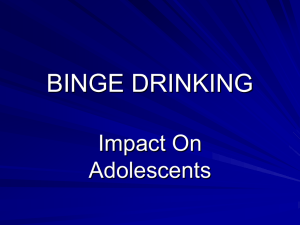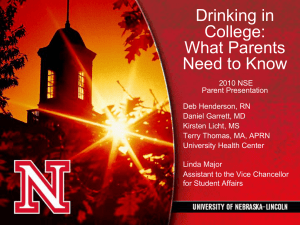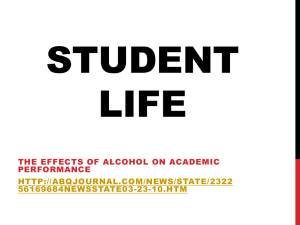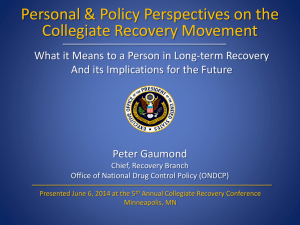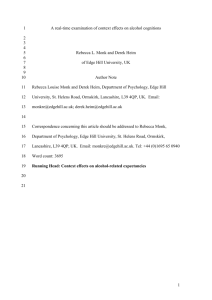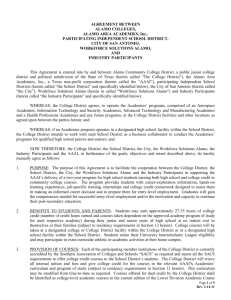An Investigation of the role of Alcohol Expectancies in
advertisement
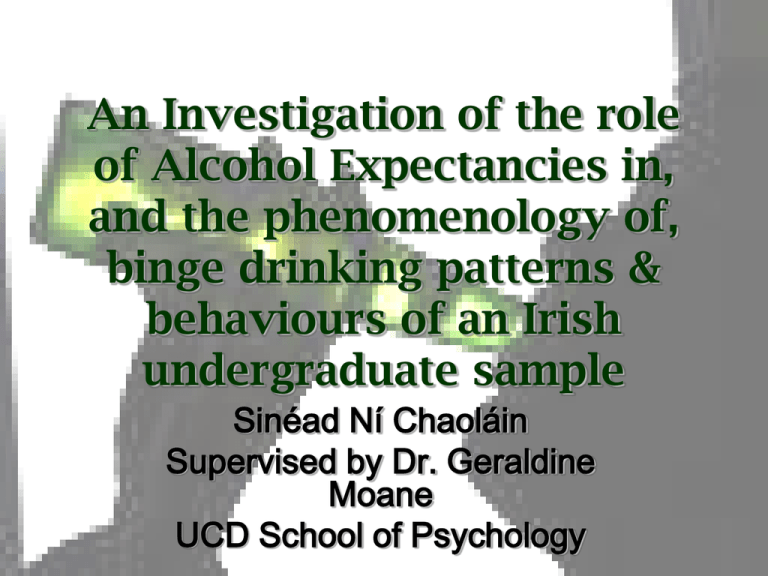
An Investigation of the role of Alcohol Expectancies in, and the phenomenology of, binge drinking patterns & behaviours of an Irish undergraduate sample Sinéad Ní Chaoláin Supervised by Dr. Geraldine Moane UCD School of Psychology Alcohol Consumption in Ireland • Alcohol has become an intrinsic part of Irish culture and society. - It’s use has become “deeply woven into our national identity” Mongan, Reynolds, Fanagan and Long, (2007) • Heavily associated with emotional situations and plays a key role in social ritual as a social lubricant Mental Health Foundation, (2006) Alcohol Consumption in Ireland • Sharp rise in volume of alcohol consumed in Ireland during the past two decades: – 48% increase in consumption per capita during the period 1986 – 2006 – Reached a peak in 2001 of 14.3 litres of pure alcohol per adult (persons aged over 15 years of age) – Drinks industry in Ireland estimated to be worth €6.9billion in 2008 – Currently ranked as third highest consumer of alcohol in Europe Union after Luxembourg and Hungary. Hope, (2007). Alcohol Consumption in Ireland • Abstention rate in Ireland represents 23% of the population – therefore, drinking population are consuming more alcohol than statistics indicate. • Therefore, higher proportion drinking at harmful levels O’Farrell, Allwright, Downey, Bedford & Howell, (2004) Binge Drinking Definitions: • A pattern of heavy drinking that “occurs in an extended period set aside for the purpose” World Health Organisation, (1994) • The consumption of a large quantity of alcohol in a relatively short period of time, usually with the pre-determined and specific aim of getting drunk Mongan et al, (2007) Consequences of Binge Drinking • Alcohol implicated in between 25 and 40% of Irish Accident and Emergency admissions, 23% reported as being acutely intoxicated – 92% increase between 1995 and 2004 • Heavy consumption associated with increased vulnerability to levels of mental illhealth – “greatest clinical problem facing general adult mental health services” Foster, (2001) Consequences of Binge Drinking • Significant relationship has also been established between alcohol consumption and criminal or antisocial behaviour; - for example alcohol has been found in numerous studies to be the substance most significantly associated with Drug Facilitated Sexual Assault Hindmarch & Brinkmann, (1999); White, (2000); Hall & Moore, (2008) Alcohol expectancies • Defined as comprising a network of cognitions that serves to organise our individual understanding of how alcohol affects the mood, behaviour and cognitive capacity of ourselves and others; - that is the expected consequences of alcohol consumption act as principal mediator in it’s occurence Knight & Godfrey, (1993) Why conduct the study? • Significantly more alcohol and other substances consumed by young people in college/university than peers living at home or who directly enter the workforce after second-level education; • time of particular vulnerability regarding development of problem drinking and other risk-taking behaviours. Aim of the study • To examine the phenomenology of the binge drinking culture that has developed in Ireland, particularly within the young adult population, over the last two decades. • To investigate the role of Alcohol Expectancies in the levels and patterns of alcohol consumption of Irish undergraduate college students and why harmful patterns of alcohol consumption continue despite experience of negative consequences. The current study: • The current study will involve the following measures: - demographic data - alcohol consumption: Measures used in national studies for comparative purposes (eg. Palmer & O’Reilly, 2008) and the Khavari Alcohol Test (Khavari & Farber, 1978) - alcohol expectancies: Alcohol Outcome Expectancy scale (Stacy & Leigh, 1993) - frequency of experienced negative consequences: The Rutgers Alcohol Problem Index (White & Labouvie, 1989) • • • • Participants Sample consisted of 303 UCD students 148 male, 155 female Age range of 18 – 25 years Mean = 19.35 years; Standard Deviation = 1.351 • 73 resided on-campus, 83 off-campus and 147 resided at home with parents • Participants were recruited through convenience sampling, consisting of the administration of questionnaires at the start/end of lectures and an on-campus convenience sample Table 1 Summary Data: choice of alcoholic beverage Results: • Khavari Alcohol Test: • 12litres of Annual Absolute Alcohol Intake (AAAI) for males and 6litres of AAAI for females indicates harmful levels of consumption • 50% of participants drinking in excess of 16litres of Annual Absolute Alcohol Intake Table 2 Pearson Correlation Matrix Results: • Two-way between groups MANOVA: Impact of Alcohol Consumption on Alcohol Expectancies and Experienced Negative Consequences 3 Dependent Variables: Frequency of experienced negative consequences (RAPI) Positive Expectancies Negative Expectancies Results: • Both AAAI and Quantity were found to have a significant impact on the combined dependent variables; F(6, 568) = 5.037, p < .01; Wilks’ Lambda = .902; partial eta squared = .051 F(6, 568) = 6.015, p < .01, Wilks’ Lambda = .884; partial eta squared = .06 • No statistically significant interaction effect Results: • When results were considered separately: RAPI found to be significantly impacted by both AAAI and Quantity; F(2, 286) = 11.936, p < .01; partial eta squared = .017 F(2, 286) = 16.473, p < .01; partial eta squared = .103 No statistically significant interaction effect Results: AAAI was also found to have a significant impact on Positive Expectancies: F(2, 286) = 7.679, p < .001; partial eta squared = .051. No statistically significant interaction effect Results: • Two-Way Between Groups MANOVA: Impact of Gender and Residence during Term on consumption pattern 3 Dependent Variables: Frequency of experienced negative consequences (RAPI) Annual Absolute Alcohol Intake Frequency of consumption of 5 or more drinks (Binge) Results: • Only gender was found to have a significant effect on combined variables: F(3, 289) = 16.702, p < .01, Wilks’ Lambda = .857; partial eta squared = 0.143 No significant effect of Residence during Term No significant interaction effect Results: • When results were considered separately: Gender found to have significant impact on each of the 3 variables: RAPI: F(1, 291) = 7.694, p < .01; partial eta squared = .026 AAAI: F(1, 291) = 44.821, p < .01; partial eta squared =.1333 Binge: F(1, 291) = 9.433, p < .01; partial eta squared =.031 Phase 2: Qualitative study • The qualitative study (Study 2) consisted of interviews conducted with a convenient sample of 12 participants (m:f=1:1) – To provide an in-depth exploration of students’ reasoning as to their own patterns of consumption, experience of intoxication, negative consequences, and the impact of these on the student. • Qualitative data initially analysed using a Thematic Analysis (Braun & Clarke, 2006) • Revealed a number of key themes, including; – the belief and expectation that drinking pattern would change – the lack of credibility of public discourse and policy in relation to binge drinking – the role of self-esteem and beliefs about the self – a sense of contextualised social anxiety – ‘Irishness’: cultural context and influence • Overarching theme of contradiction and denial throughout – corroborates quantitative findings • This analysis highlighted the complexity of factors inherent in binge drinking Some responses: • “So like, the pre-drinking bit, I think that loads of people do that now, it’s kind of like the part to get drunk, to get really drunk in and then by the time you get into the club just have a couple more...” • “...well this is one common to everybody, you feel, you feel more confident when you’re drinking but as I said like confidence it’s not, I don’t drink to, to feel confident, I just happen to feel more confident when I’m drinking...” Some responses: • “...like I used to worry about getting drunk to have a good time...” • “...it would feel [going out and not drinking alcohol] like you were automatically, people would think, oh because she’s not drinking she’s not having fun, even if you were having fun it just kind of seems like people mightn’t be as willing to like engage with you like, kind of, you do feel different, like you’d be oh she’s driving, she’s not drinking like, she’s not up for as much of a laugh...” Go raibh míle maith agaibh! sinead.nichaolain@ucdconnect.ie


